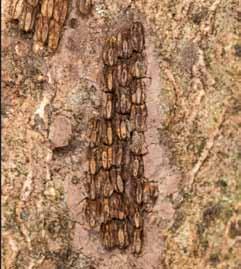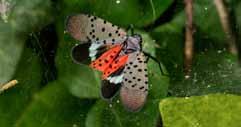
4 minute read
The Commons
Spotted Lanternfly
Spotted lanternflies can be found on trees all over Queen Village, South Philadelphia and beyond, but do you know how they got here or what their lifecycle looks like?
by Meredith Piotrowski
The Pennsylvania Department of Agriculture identified the Spotted Lanternfly as a threat shortly after it was first seen in the Keystone State in 2014. Native to Asia, it targets cultivated grapes, fruit trees, and hardwood trees. Eradication in the early stage of its life cycle is crucial.
Lanternflies spend winter here in egg masses on everything from bark and stone, to flat surfaces including yard furniture and cars. To the casual observer, these egg masses can be mistaken for a clump of mud. In the next stage they emerge from their eggs in May, with a second molting in late May. Still wingless at this point, they can only crawl or jump. The adult lanternfly usually appears around July, seeking out food sources from September through December in order to double in size for egg-laying.
Lanternflies feed on native species, including willows, maples, poplars, birch and ash, many of which are found lining the streets of Philadelphia. Damage to trees appears as “wounds,” weeping with sap, and sooty fungal growth at the base of the tree—telltale signs that a tree’s life is in danger.
The PA Department of Agriculture received a $5+ million grant to study and control spotted lanternfly populations. If you would like to make a report, visit services.agriculture.pa.gov/SLFReport and help stave off the impacts of the lanternfly, and save our local tree treasures. ■
The Perfect Pandemic Activity:
Socially Distance while Saving Neighborhood Trees
Now that you know what to look for at each stage of the Lanternfly life cycle, you have the knowledge to destroy as many as possible—all at a safe, social distance.
Fall is the prime eating and destroying stage for these tree predators. Bella Vista neighbor Amy Cornelius led a walking workshop to educate neighbors about what to look for. She honed her skills fighting lanternflies in Chester County, where she works in estate management and landscaping. She even created her own “scraping tube” to reach the ones up high and deposit them into bleach. “But I’ll even bring out a shop vac and vacuum them off trees—they don’t really fly, they pop. And move really fast.”
Lanternflies are currently feeding to support the 20 to 40 eggs they will lay in

each sack this winter, so smash them with your foot or slap them with a shoe whenever possible. “I have observed them travel up a tree in a triangular leadership with one looking back to see danger. When that one notices you, they move faster or scatter. I’m convinced they work as a pack.”
Effective treatments are tough. Amy has seen lanternflies walk over stickybanded trees and says that insecticides may weaken tree bark and can hurt woodpeckers and native bees. That’s why physically destroying as many as possible is best. “You’re the only real predator for these things. Think of yourself at the top of this food chain.”
Amy will be leading another free workshop September 12 through Queen Village for adults and kids. In the meantime, smash as many as you can. ■

iberty ree
by Thomas Paine
In a chariot of light, from the regions of the day, The Goddess of Liberty came, Ten thousand celestials directed her way, And hither conducted the dame. A fair budding branch from the gardens above, Where millions with millions agree, She brought in her hand as a pledge of her love, And the plant she named Liberty Tree. The celestial exotic stuck deep in the ground, Like a native it flourished and bore; The fame of its fruit drew the nations around, To seek out this peaceable shore. Unmindful of names or distinctions they came, For freemen like brothers agree; With one spirit endued, they one friendship pursued, And their temple was Liberty Tree. Beneath this fair tree, like the patriarchs of old, Their bread in contentment they ate, Unvexed with the troubles of silver or gold, The cares of the grand and the great. With timber and tar they
Old England supplied, And supported her power on the sea; Her battles they fought, without getting a groat, For the honor of Liberty Tree. But hear, O ye swains (’tis a tale most profane), How all the tyrannical powers, Kings, Commons and Lords, are uniting amain To cut down this guardian of ours. From the East to the West blow the trumpet to arms, Thro’ the land let the sound of it flee; Let the far and the near all unite with a cheer, In defense of our Liberty Tree.

Facing page: An adult lanternfly and late-stage nymph. Above: The life cycle of a lanternfly: Egg mass; late-stage (with red patches) and early-stage nymphs (black with white spots); and adult with wings spread. (Photographs: U.S. Department of Agriculture)
215.886.6111 (Glenside, PA) 215.725.3637 (Philadelphia, PA) 215.572.6937 (Fax) www.libertytreecare.com
MIKE DUFFY

Certified Arborist PD-1766A

